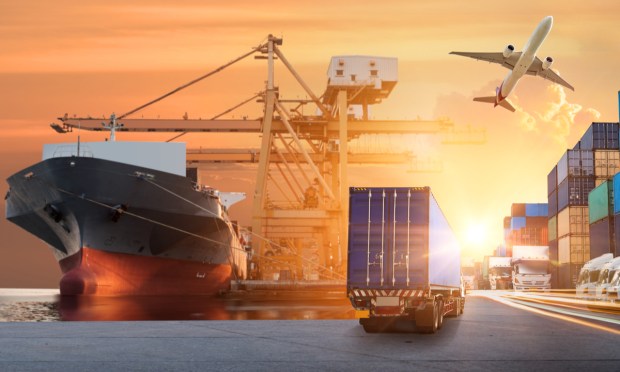Industrial Economy’s Recent Advances Were Built on Ancient History

In 1956, U.S. businessman Malcolm McLean was granted a patent for his intermodal shipping container.
Today, tens of millions of shipping containers provide the critical capacity for much of the world’s transport needs.
The supply chain and logistics sector, as well as the industrial economy more broadly, has never be the same since McLean’s invention.
At least until the invention of the barcode, the next great logistics evolution, nearly 20 years later. First used in 1974 for tracking and inventory management, barcodes are now a bedrock of smooth-running supply chains around the world.
Now, nearly half a century later, change-the-game innovations like artificial intelligence (AI), computer vision, IoT (internet of things), and more are transforming the logistics space at an even faster pace, reinforcing consumption as a driving force in human nature and continually positioning the movement of goods as an unsung engine of civilization.
A seismic shift in digital technical capabilities is reframing the possibilities — and efficiencies — of the global shipping and transport landscape.
In honor of National Logistics Day Wednesday (June 28), take a trip back through time with PYMNTS and discover what the industrial sector’s most pivotal advances of the past could hold for tomorrow’s connected innovations.
After all, the way goods move around the world directly informs the way business is done around the world — with operational wins (and losses) increasingly defining crucial B2B dynamics and relationships.
Read more: Digital Platforms Look to Speed Logistics Sector Innovation
The Birth of Standardized Industry: 1875 – 1950
The birth of the second industrial revolution changed logistics considerably, not the least of which was by implementing the idea of economic order quantity: a method for estimating the most cost-effective number of items to purchase from suppliers, based on costs, first published in the Harvard Business Review in 1934.
Coming out of World War II and into the third industrial era, supply chain lessons from the military action transformed the shipping, freight, and logistics sector by simplifying cargo handling, reducing costs, and enabling efficient intermodal transportation via standardization.
From the 1940s on, logistics technology shifted from manual labor to using mechanized ways of moving goods, with transport shifting from rail to truck.
Logistics when done well is a practically invisible endeavor, but its advances generally have far-reaching and foundational effects across daily life, business operations and the global economy.
The industrial era at the turn of the 20th century kicked off a tremendous arc of innovation that we are still enjoying to this day, over a century later.
Early industry lessons of standardization and leveraging mathematical models for inventory forecasting have since snowballed into key operational pillars of today’s logistics landscape.
The Emergence of Computers: 1960 – 1990
The pattern of progress is marked by periods of steady improvement, broken up by technically driven operational phase shifts that transform historic processes.
The invention and commercialization of computers in the mid-20th century revolutionized logistics planning, inventory management and optimization of truck routing — and laid the groundwork for the data revolution that would take place next.
Large-scale optimization models were incorporated into commercial operations and early innovations in automation took place along critical junctures in the supply chain journey.
Globalization and increasing internet access dominated logistics development, capturing efficiencies across mass production and lean manufacturing, eventually resulting in the creation of enterprise resource planning (ERP) systems to manage the rapid growth of collected operational data. The term “logistics” arose, as did the notion of “supply chain management.”
The stage was set for providing an unprecedented level of transparency and information as goods were increasingly flowed and tracked in real time through diverse and complicated systems.
See also: Real-Time Insights Bring Clarity to Chaos of Global Logistics Sector
The Information Revolution: 1990 – 2010
While containerization goes back to 1954, it truly took off in the 1990s when paired with connected inventory tracking and management tools.
The significant impact standardized shipping container had on the logistics sector revolutionized global trade by simplifying cargo handling, reducing costs, and enabling efficient intelligence across far-flung operations.
Electronic data interchange (EDI) would also revolutionize document exchange in the logistics industry during this period as well by replacing paper-based processes with electronic data transfer, enabling faster and more efficient communication between different entities in the supply chain.
Providing the overarching technical infrastructure during the early aughts was the emergence of both GPS technology and cloud computing. GPS allowed precise tracking and tracing of shipments and improved fleet management and facilitated route optimization, while helping reduce transportation costs.
The rise of cloud computing offered scalable and cost-effective solutions for logistics companies by enabling better collaboration, data sharing, and accessibility to information across the supply chain.
These advances provided a scalable foundation for the technical innovations that would disruptively reshape the logistics sector in the years ahead.
An Ongoing Digitization: 2010 – Present
As Will Hansmann, CTO at project44, told PYMNTS, “the core problems [in global shipping and logistics] are ultimately about order and inventory visibility. What is moving? Where is it moving? What container is it in? The expectation today is that customers will have real-time visibility into where everything is.”
Fortunately, today’s technical infrastructure, tailor-made to provide asset-level supply chain insights around location and condition and powered by next-generation technologies including IoT, AI, data analytics, and other sixth wave innovations, is increasingly giving firms the predictability they need around previously unknown areas within their supply chain processes.
That’s because the shipping and logistics industry is particularly primed to capture future-fit efficiencies through next-generation tech solutions, like generative AI and natural language processing (NLP).
These new tools can drive dynamic, conversational interactions for customers while leveraging innovative, low-friction ways to surface supply chain insights and intelligence in real time.
“The rapid speed of technical adoption over just the past seven years has been incredible and frankly enormous in this industry,” Fernando Correa, CEO and co-founder of international digital trade company Cargobot, told PYMNTS in an earlier discussion.
The world is only growing more connected and digitized, resulting in a constant evolution of the industry.
“Since I began to work in this industry, things have rapidly evolved. Five years ago, no one wanted to pick up your call or answer your email, now people are asking what is AI and how can it help, what is an API [application programming interface]?” Raz Ronen, CEO at FreightTech startup Wisor.AI, said earlier this year to PYMNTS.
And elsewhere, ongoing advancements in robotics and automation have led to the adoption of automated warehouses, while robots are increasingly being used for tasks such as order picking, sorting, and inventory management, resulting in improved efficiency and reduced labor costs.
The most successful business relationships are modern, integrated ones where information sharing and data-driven, real-time updates produce beneficial results for all parties. Simplification across the industry as a result of modern tools will be ongoing — creating an operating landscape of shared efficiencies fundamental to building better B2B relationships.

